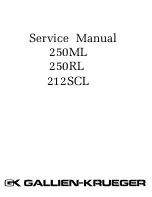
Fredenstein HD Reference Preamplifier
manual to have some space above and below in the rack. Think about how hot a 15 watt
incandescent lightbulb gets.
The Commander Remote Control
The Commander Remote Control unit looks very similar to the HD Reference and notably ALL of
the controls are included. Only the meters are missing on the Commander, as there is no audio
involved in this box to meter. In the control room, one typically uses the meters of the recording
device. However, the Commander does have a two color LED to show signal presence when lit
GREEN or near clipping (+24 dBm) when RED. Generally, if the LED is lit GREEN and not
flashing RED, you are probably in the safe zone as far as the HD Reference, but you still probably
want to avoid overloading the recording device, so those meters are worth watching. However, the
best thing is to use your ears and if it is seeming like there may be some unwanted warmth and mid
range build up, probably turning the Gain down will help. Alternatively, maybe you want some
warmth and color, so increasing the Gain should get you there, but you may have to turn down the
gain elsewhere or insert a compressor after the HD Reference to prevent overloading an analog to
digital converter.
The Commander does have one button that the HD Reference does not, but does have a
corresponding indicator. This is the LOCK button. If the HD Reference pre-amp is located some
distance away, it is possible that someone might push a button accidentally (like P48) or just
tampers with sett
Fredenstein includes a pair of short 3 meter mic cables with the Commander remote. We encourage
you to place the HD Reference in close proximity to the microphones and use mic cables that are as
short as possible. Long cables can introduce appreciable capacitance into the chain. In extreme
cases, this might attenuate high audio frequencies. In less extreme cases cable capacitance can
affect phase response at 20K and can be a difficult load for some microphones to drive and maintain
the optimum wave-shapes. To get full benefit of the very wide bandwidth and fast impulse response
of the HD Reference , we do suggest short low capacitance mic cables. Good shielding and low
micro-phonics can also be important, depending on the gain needed and whether phantom power is
used. This is why we include a pair of good quality short cables with the Commander.
The control cable for the HD Reference can be a typical balanced mic cable. The jacks are labeled
“Commander” at the preamp and “Preamp” at the Commander remote control. The communication
technology is similar to 2400 baud modems that we used in the 90's to connect computers to phone
lines. The signal can be patched through a conventional patch bay and run significant distances. The
signal is transformer isolated, balanced and low level to avoid cross-talk to audio lines. And like a
phone line signal it is bi-directional, so one cannot route it through digital snakes that are intended
to convert and pass a signal in one direction. The main thing to avoid is routing this signal to the
console because, frankly, it just sounds like an old computer modem.
The gain control encoders may seem a little slow with the Commander connected. This is because
each step is communicated to the preamp and the message acknowledged. This ensures accurate
data sent and near zero chance of a fault in communication. You can be confident that when the
Commander remote is displaying a setting that the setting is exactly the same on the HD Reference.
And if the LOCK button is pressed on the Commander, you can be confident that nobody can mess
with the settings of a HD Reference that may be out of sight.
Fredenstein HD Reference Manual V1.0 Feb 5, 2016 Page 11































